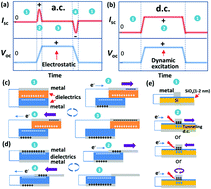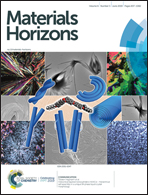Interfacial friction-induced electronic excitation mechanism for tribo-tunneling current generation†
Abstract
Direct-current (d.c.) electricity generation using a moving Schottky contact is emerging as a new strategy for mechanical energy conversion. Here, we demonstrate the generation of d.c. tunneling current with a density of ∼35 A m−2 at a metal–insulator–semiconductor (MIS) sliding system using micro-tips. The measured current densities were found to be two to three orders of magnitude higher than that observed with the conventional polymer-based triboelectric nanogenerators (TENGs). The electromotive force ΔVs* for the tribo-tunneling transport comes from the dynamic electronic excitation at the frictional interface rather than from the electrostatically trapped surface charges as in the case of conventional TENGs. The strong electronic excitation can give rise to a non-equilibrium interfacial charge variation Δσm. Depending on the energy distribution of the excited electrons/holes, Δσm subsequently dissipates non-adiabatically into tunneling current and trapped surface charges, or adiabatically into heat. These fundamental results not only enhance our understanding of the triboelectric phenomenon, but also open up new paths for the development of next-generation mechanical energy harvesting and sensing techniques.



 Please wait while we load your content...
Please wait while we load your content...